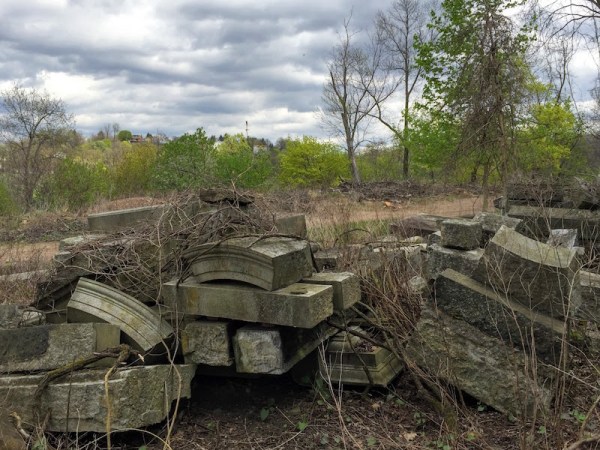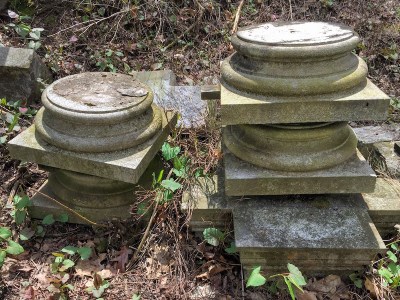Editor’s note: This story generated no small amount of controversy. After a discussion with the cemetery’s president, we made the decision to update the story, removing certain identifying details for general public safety. Based on the many questions raised by the piece, we responded with the follow-up story “Where Do Gravestones Go To Die?”
The simple grave marker is nothing out of the ordinary. Gently curved and smoothly hewn, the stone is a standard off-the-shelf/out-of-the-catalog mid-century model we’ve seen hundreds–perhaps thousands–of times in different plots over the years. About the size of a microwave oven, it has raised block letters on its face which detail only the most basic facts about the deceased: Frederick W. Zinsser, 1878-1942, Father.
What’s strange about Frederick Zinsser’s headstone is how it arrived in its current position–upside-down, squashed between two felled trees, in a hidden, barren spot just outside the cemetery’s otherwise beautifully-groomed and spectacularly-scenic acres of visiting space. Oh, and why is it surrounded by dozens of other gravestones and stray cemetery infrastructure that appear casually tossed in the dirt like children’s playthings at the call for dinner?
We’re not talking about just a few stones–a pile here and a pile there. No, the graveyard for gravestones is extensive. It’s a big, basin-shaped open area just downhill from the older side of the cemetery. By now–in early May–you probably wouldn’t even notice it. But when we visited on Easter Sunday the thin shroud of young trees hadn’t yet fully sprouted all its leaves, allowing this unsightly broom closet of quickly-tossed granite to be impressively available to the passer-by.
This graveyard-within-a-graveyard contains piles and not-so-neatly-stacked collections of granite monument trimmings, grave edging, foundations, pedestal bases, supporting structural elements, and a least a couple full cemetery buildings, deconstructed and laid out like parts to-be-assembled in an Ikea box.
The stones didn’t just get dropped-off yesterday. They’ve got several years worth of viney overgrowth climbing in, on, and around the various pieces; a number of fall seasons’ downed leaves mulching their bases.
In the head-heart continuum, we tend to want the cemetery to be the final place where one may rest in peace…forever. We also know that nothing actually lasts that long. Most of the time, for good or bad, we won’t have the chance to confront that reality. But seeing dozens of (literal) set-in-stone, lifetime memorials uprooted from their primary locations and dumped in a strange public-private boneyard junkyard makes it all the more obvious.
We don’t know why these gravestones were uprooted or why the cemetery has dumped them so casually right in the middle of the property. The Orbit maintains a strict “don’t ask, don’t tell” policy toward clarifying these matters, preferring to speculate and wonder over the cruel realities of truth.
That said, it seems like a strange business move for the marketing side of the cemetery. Will customers really want to buy that plot seeing the downed markers so nearby? And–assuming there are legitimate, practical reasons for the markers’ removal–why can’t the grounds crew at least put the retired stone in some kind of relative respectful order?
We imagine the current market for used gravestones is pretty low. That said, there simply must be more interesting uses for this substantial supply of unique historic, hand-cut, and incredibly-durable pieces than just sweeping them under the cemetery’s rug of fallen leaves.
The stockpile could absolutely be turned loose for artists to work with, used to decorate public spaces around the city, or recycled by monument makers into new graves. Speaking from experience, those of us who haunt the cemetery and ponder how the whole thing works would appreciate an educational display explaining how and why all these elements ended up displaced from the humans they once memorialized.
For our purposes, however, it’s a kind of weird disaster cool just as it is. The area evokes something between an Easterner’s imagination of the catastrophic wreckage following a big earthquake and the post-armageddon chaos that seems more likely every day. In zombie-obsessed Pittsburgh, we can picture the living dead rising from their crypts and casually tossing headstones like beach balls at summer concert. Perhaps the whole thing is social commentary: in just a couple months, The North Side can look forward to a similar scene in the wake of Kenny Chesney’s inevitable mid-summer return–only we may end up with more dead bodies around Heinz Field.









That spot is where the cemetery does “clean up its mess”.
Its where the maintenance crews dump fallen autumn leaves and trees and dilapidated monuments. Its up to the family of the deceased to maintain their plots and monuments. Suggesting that people should remove those remnants from the cemetery seems callous and irresponsible.
LikeLike
GRRG63: In no way do we mean to suggest that any part of the cemetery should be looted. The pieces that ended up in this area are most-likely decommissioned for very good reasons–the body has been moved, graves have been consolidated, etc. Many cemeteries then take a follow-on step to destroy (or at least, deface) the retired markers. Our suggestion here is simply that if a stone has reached its, um, “end of life” (sorry) as a grave marker, it may be possible to have a blessed afterlife–*with the full permission and participation of all affected parties*. Personally, I believe that’s a much more reverent and responsible use of the gravestone than just letting it get ground to dust.
LikeLike
Why are in buisness that is none of your buisness, before you print a story get the facts. If the family no longer maintains the plot and no next of kin is reachable then it can be removed. The casket remains untouched just the marker can be removed. It is the cemeteries property and can do what they want. Its your opinion of what they should or shouldnt do. But none of your buisness. The Cemetery is for visiting loved ones not a playground for nosy people
LikeLike
Ryan: What facts do you believe are distorted in the piece? Those photos are absolutely real–they were collected from a publicly-accessible area of the cemetery that didn’t contain any kind of “Do Not Enter” signage. Other than the photos, everything else in the piece is very clearly just description of the scene and some questions about how and why things got like this.
I agree that there are all kinds of reasons why a grave marker may be legitimately removed and I say that in the piece. It just seems very strange that the cemetery would chose to dump them in such a public place where any of your “visiting loved ones” can easily see them. Do you think the families that visit their loved ones want to see a bunch of tossed gravestones? Probably not–it looks really bad. If you disagree with that, as you say, that’s your opinion.
LikeLike